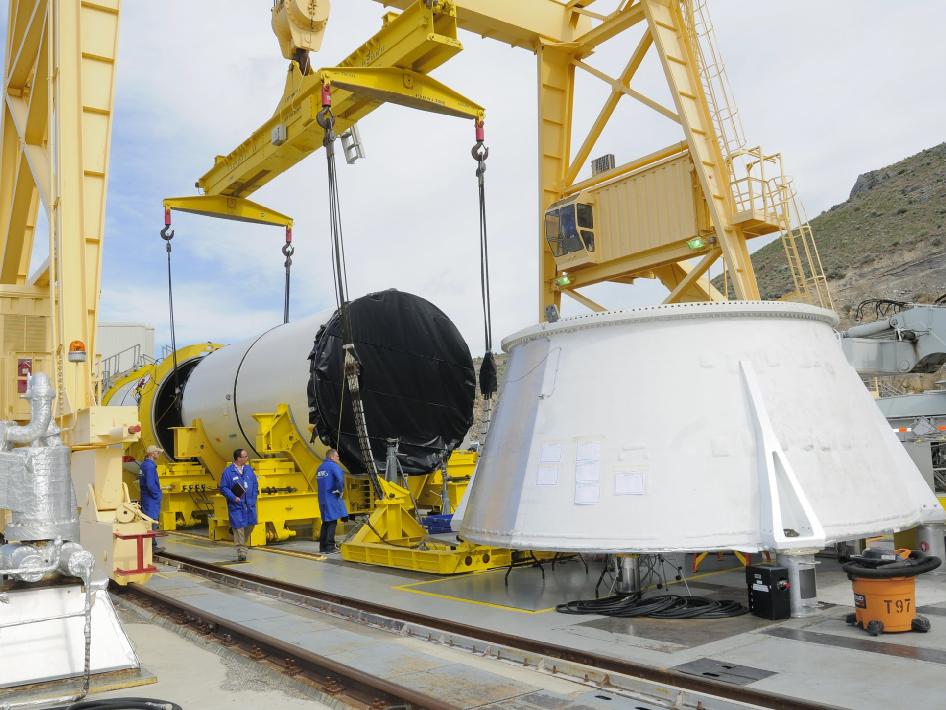
ATK and NASA have had to postpone the upcoming ground test of the Qualification Motor (QM)-1 due to one of the segments not meeting testing criteria. As such, it will not be used for the next hot-fire test, which takes place in the Utah desert. AmericaSpace spoke with ATK representatives to learn what was at the heart of this issue.
“One segment of the Space Launch System (SLS) Qualification Motor (QM)-1 ground test booster did not meet test criteria and will not be used for the next hot-fire test, “ said ATK’s Trina Helquist. “During routine X-ray inspection that followed the casting of the propellant, un-bonds and voids were found. Un-bonds are areas where the propellant did not adhere to the insulation/lining of the case. A void in this situation is an air pocket in the propellant.”
These issues were only discovered in the booster’s aft segment, which is one of five segments that comprise the rocket motor that tracks its history through the space shuttle’s twin Solid Rocket Boosters, or “SRBs.” Similar problems were not seen in the three prior Development Motor tests that ATK conducted.
Engineers conducting extensive inspections of the components discovered these problems via X-ray and ultrasonic techniques. The inspections let engineers peer into the motor to discover problems well in advance of the test-fire. Tests such as these are standard operating procedure for the NASA/ATK team.
According to ATK, all of the components of QM-1 have been surveyed and no other issues have been located. The four other segments are currently in the test stand waiting testing. ATK stressed that their highest concern was to ensure that the boosters would operate as advertised.
“The QM-1 tests are important as they qualify the design for flight. As such, it is critical for these boosters to be uniform in composition so that they will burn as designed. This segment did not meet test criteria and will not be used. The finding of this anomaly is an example of why we inspect the boosters and how we establish a high reliability of these systems,” Helquist added.

The inspection process includes full inspection of the bond line between the propellant and the lined insulation. The investigating team, comprised of representatives from both ATK and NASA, is currently working to discover the root cause of the problems discovered in the aft segment. Given that the aft segment’s geometry is different than the others, the team is paying close attention to see if that could be the cause of these voids.
For its part, ATK does not feel that this issue will impact other testing objectives for SLS’ boosters.
“QM-1 is not on the critical path for the first flight of SLS in 2017, and there is margin in the schedule to resolve this anomaly,” Helquist said.
Currently, a new test-fire date for QM-1 has not been scheduled.
To date, ATK has designed, manufactured, and successfully tested three Development Motors (DM-1, -2, -3). The step-by-step process is part of an incremental approach that allows for a thorough review of the performance of these boosters. Each test in the DM series was slightly different (temperature being a key aspect that was varied between tests). Also, each of these motors was slightly different in design. This provided NASA/ATK with design options. The overall design is very similar to what is planned to fly on SLS, thus certifying the booster system for flight.
“Developing a rocket is a complex process and anomalies can occur. We inspect for these anomalies to ensure we provide a top-quality product as showcased in our success record of more than 270 launches and tests,” said Helquist when pressed about how serious her company takes the booster’s design. “NASA and ATK have a top investigation team working the issue. We are confident a root cause will be found.”
Want to keep up-to-date with all things space? Be sure to “Like” AmericaSpace on Facebook and follow us on Twitter: @AmericaSpace




2 Comments
2 Pings & Trackbacks
Pingback:Test-Fire Delayed Due to Defects Found in SLS QM 1 Aft Segment | The Newspace Daily
Pingback:Persistent Problem in Qualification Motor Delays SLS Segment Test | Space Safety Magazine